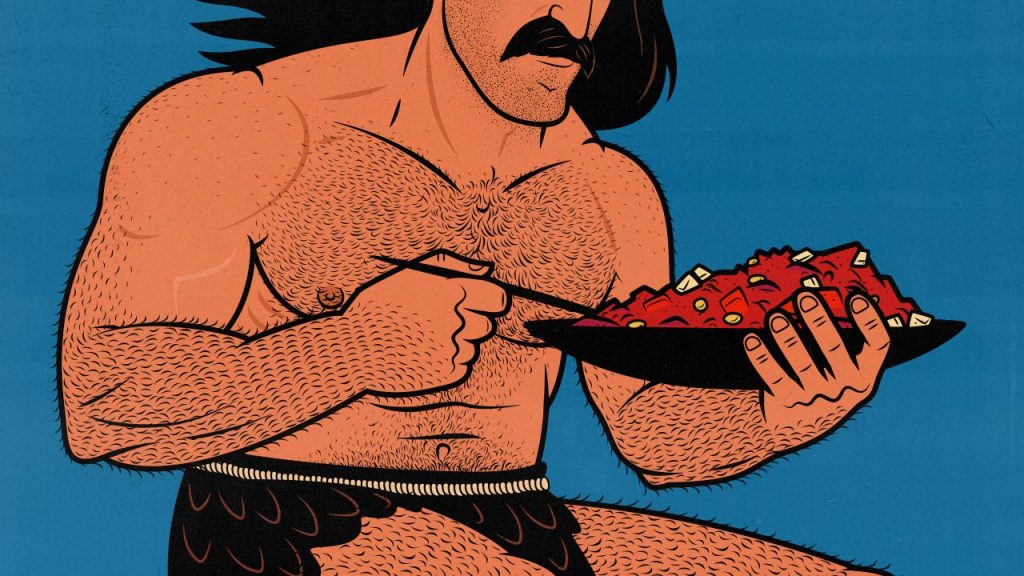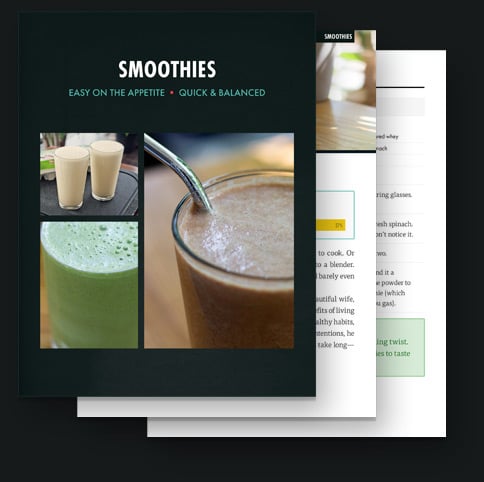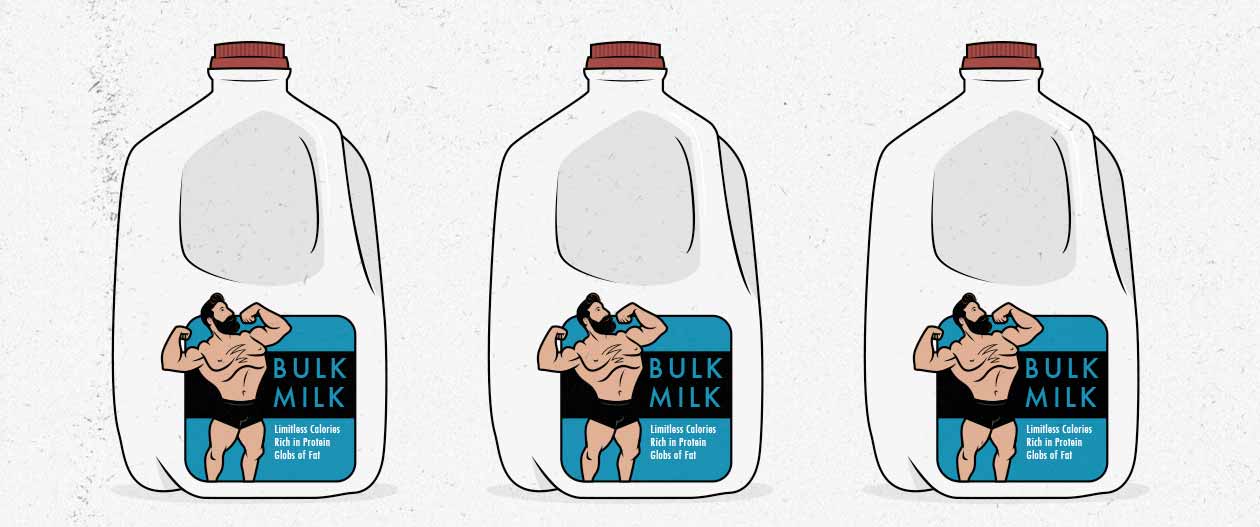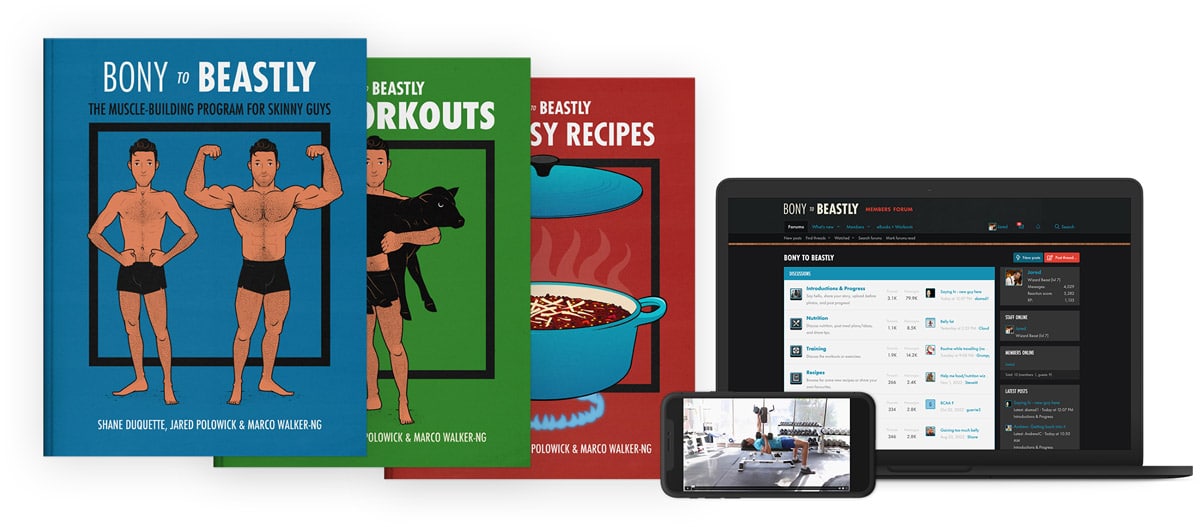
The Best High-Calorie Bulking Foods for Skinny Guys
If you’re trying to bulk up, what foods should you eat? The obvious answer is to eat high-calorie foods, making it easier to get into a calorie surplus. That’s true. But there’s a catch, especially if you’re trying to build muscle quickly, leanly, and healthfully.
We’ve been helping skinny guys bulk up for over a decade now. We’ve each gained over 60 pounds. Marco has studied under the top experts and worked with professional and Olympic athletes. Plus, there’s a rich bulking tradition we can draw wisdom from.
If you’re smart with your food choices, bulking becomes much easier. You’ll find it more comfortable to eat in a calorie surplus, build muscle faster, store less fat, have fuller muscles, better workout performance, and bigger muscle pumps.

What Makes a Food Good for Bulking?
You can bulk up with a wide variety of foods. You don’t need to eat a specific diet. You just need to eat enough good food. Even so, some foods make it much easier to bulk than others. They share a few common characteristics:
- They have a high energy density. Foods with a higher energy density have more calories per unit of volume. They take up less room in your mouth, allowing you to devour calories faster. They also occupy less room in your stomach, allowing you to eat more food before you run out of room. For skinny-stomached guys like me, that’s a huge boon.
- They’re good for building muscle. Foods higher in protein, starchy carbs (or unprocessed sugars), and healthy fats are fantastic for building bigger muscles. Protein is the building block of muscle tissue, starchy carbs are the fuel our muscles use, and healthy fats keep our hormones running smoothly, telling our bodies what to do with these nutrients. Then there are fibrous and fermented foods, which improve our digestion. And foods that improve our blood flow, enhancing our muscle pumps and growth.
- They’re good for our health. A good bulking diet is built out of nutritious foods. Think of whole or minimally processed foods, including lean meat, seafood, fruits, vegetables, legumes, seeds, nuts, dairy, herbs, spices, and much more.
Not every good bulking food satisfies all three criteria. For example, carrots and spinach aren’t rich in calories or easy to digest, but they’re packed full of micronutrients, including nitrates, giving us bigger muscle pumps and increasing our rate of muscle growth (study). You could make a similar argument for garlic, which improves blood flow.
On the other side of the spectrum, consider white rice. White rice is stripped of its fibre, making it less nutritious than other whole grains, such as brown rice, oats, quinoa, and corn. However, it still retains some micronutrients and has a few key bulking advantages: it’s high in starchy carbs, easy to prepare, easy to eat, and quick to digest. As a result, it makes for a great side, especially if you’re having it along with some salmon and vegetables or perhaps under a bed of stir fry, picadillo, or vindaloo.
The Categories of Bulking Foods
A good bulking diet is wide, varied, and made up of balanced meals. A balanced meal combines different categories of foods, mixing protein, carbs, fat, fibre, and micronutrients into a delicious dish. Even better if that dish is easy to down and easier to digest.
- Lean meat is high in protein and rich in vitamins and minerals. Leaner cuts are lower in saturated fat. Think of extra-lean ground meat, white fish, shrimp, and chicken breast.
- Fatty fish is high in protein and rich in omega-3s (such as EPA and DHA). These omega-3s reduce inflammation and support our overall health. Think of salmon.
- Eggs are high in protein and rich in healthy fats and micronutrients.
- Fermented dairy is rich in protein, calcium, and probiotics. Probiotics are great for our digestion, which is key when bulking. Think of cheese, cottage cheese, Greek yogurt, and kefir.
- Other fermented foods are rich in probiotics, too. Think of sauerkraut, miso, natto, tempeh, kombucha, and kimchi.
- Whole grains and legumes are nutritious, starchy carbs. They’ll pump your muscles full of glycogen, improving your workout performance and supporting muscle growth. They’re also rich in soluble fibre, which regulates blood sugar, blood lipids, and digestion. Think of corn, quinoa, oats, beans, lentils, soybeans, peanuts, and brown rice.
- Fruits and berries are rich in vitamins, minerals, fibre, phytonutrients, and antioxidants. They’re also a nutritious source of unprocessed sugar, giving us the energy to lift and grow. Think of bananas, mangoes, papayas, apples, pears, oranges, limes, and mixed berries.
- Fibrous vegetables are pitifully low in calories but make up for it by being rich in fibre, along with a wide range of micronutrients. Many are rich in nitrates, improving blood flow, giving you bigger muscle pumps, and increasing muscle growth. Think of carrots, spinach, broccoli, cauliflower, asparagus, beets, and peas.
- Nuts and seeds are rich in healthy fats, protein, and fibre and packed full of micronutrients. Think of walnuts, almonds, Brazil nuts, cashews, pistachios, pumpkin seeds, chia seeds, flax seeds, and hemp seeds.
- Herbs, spices, and garnishes add flavour and nutrients to your meals. Many of them have interesting health benefits. Think of garlic, onions, diced tomatoes, pepper, turmeric, oregano, cilantro, mint, hot peppers, and soy sauce.
- Sauces and dips are another way to add joy to your meals. Many of them are quite nutritious. Think of honey, mustard, nut butter, soy sauce, hot sauce, tahini, homemade mayonnaise, olive oil, vinegar, hummus, salsa, Tzatziki, and guacamole.
- Oils have the highest energy density of any food. Extra virgin olive oil is great for drizzling on salads and veggies. Avocado oil is great for cooking with.
- Coffee and tea are natural sources of caffeine and rich sources of phytonutrients. They’re quite healthy, provided you keep them away from bedtime.
get our bulking recipes—smoothies, snack, & protein balls
4 free bulking recipes

Get four bulking recipes in a downloadable PDF file. Get the full explanation, ingredient list, macros, and steps to follow.
Plus, we’ll make sure you’re on the b2B newsletter, and send you all of our best muscle-building content.
The Best Bulking Foods
If you have a large stomach and a fearsome appetite, pile your plate high with all kinds of nutritious foods. You don’t need to discriminate. However, skinny guys often have faster metabolisms and smaller stomachs, making it incredibly hard to eat enough food to gain weight. So, to help your bulk go more smoothly, let’s go over some of the most popular and powerful bulking foods, many of which make it easier to eat more calories.

Bulking Smoothies
Smoothies are arguably the best bulking food of all time, especially if your diet isn’t very good, and especially if you’re struggling to eat enough calories. Nutritionally, smoothies are perfect, blending together a balanced mix of healthy foods. Blending those foods makes them calorically denser and easier to digest. Smoothies are like a mass gainer but more nutritious.
Here’s a simple recipe for a bulking smoothie:
- A handful of mixed nuts (28g)
- A cup of frozen mixed berries (140g)
- A handful of spinach (30g)
- A banana (118g)
- A cup of non-fat Greek yogurt (245g)
- A cup of water or milk (244g)
With water: 485 calories, 32g of protein.
With milk: 565 calories, 40g of protein.
For more, we have a full article on bulking smoothies.
Nuts, Peanuts & Nut Butter
Nuts have an incredibly high energy density, making them a great source of calories while bulking. They’re one of the healthiest sources of fats, they often contain some fibre, and the minerals found in nuts (such as magnesium) are great for testosterone production and muscle growth. As a bonus, you’ll usually get a few grams of protein.
- Almonds
- Walnuts
- Cashews
- Pistachios
- Pecans
- Macadamia nuts
- Brazil nuts
- Hazelnuts
- Peanuts
Mixed nuts make for a great default. That way, you get a wider variety of nutrients. An interesting tidbit about Brazil nuts is that they’re incredibly high in selenium. Some guys use them as a selenium vitamin, having two every day with breakfast. I’m one of those guys.
An easy snack is to slice up an apple and dip it into peanut or almond butter. You get nutritious carbs and fibre from the apple, and you get healthy fats and protein from the nut butter. It’s a surprisingly balanced bulking meal.
Dried fruits
Dried fruits are a fraction of the size of regular fruits, yet they have just as many vitamins, minerals and fibre. In fact, if you compare dried fruit against fresh fruit by weight, dried fruit contains about 3.5 times the amount of fibre, vitamins and minerals as fresh fruit.
Trail Mix
Trail mix is my favourite bulking food. It combines the many benefits of mixed nuts with the benefits of dried fruits, creating an absolute muscle-building masterpiece. Now, I know this will sound crazy, but I find trail mix much more enjoyable to “drink” than to eat. I put my trail mix in a cup and sip on it. (I still chew it, of course.)
Muesli cereal (trail mix + milk)
Muesli, like trail mix, is a blend of several bulking foods. It’s usually made by mixing together oats, grains, nuts, and dried fruits. You can add some milk or a milk alternative and eat it like cereal.
Dark Chocolate
Dark chocolate is a great source of healthy fats, minerals, and antioxidants, making it a wonderfully healthy bulking food. It’s also calorically dense and easy to digest, which will help us gain weight. Chocolate is also rich in a compound called epicatechin, which helps to dilate blood vessels and improve blood flow, producing a similar effect to pre-workout supplements like L-citrulline. (Prunes do this as well.)
Bulking tip: add dark chocolate chips to your trail mix, muesli, or Greek yogurt with berries.
Bananas
Bananas are one of the most calorically dense fruits, and they’re also a great source of prebiotics, which is important for keeping your digestive system running smoothly. Here’s how to add them to your bulking diet:
- Have them as a side with breakfast.
- Blend them into your smoothies.
- Have them as a pre-workout snack.
- Add banana slices to your muesli or Greek yogurt.
Milk
Milk is one of the most famous bulking foods of all time. It’s a convenient source of calories and protein and rich in calcium, zinc, selenium, magnesium and many other nutrients. Milk is also mysteriously anabolic, with some studies showing it accelerates muscle growth (study, study). It’s unclear why.

Milk is also easy on the appetite and passes through our digestive systems fairly quickly, freeing up more room for more food. Skim milk has about 375 calories and 36 grams of protein per litre. Whole milk has 630 calories and 32 grams of protein per litre. That means if you added a litre of milk into your diet, you could expect to gain 0.5–1 pound per week.
Greek yogurt (and Cottage Cheese)
Greek yogurt is high in protein and a great source of probiotics. It works well in smoothies, can be added to cereal, and makes for a great snack. You can get the full-fat or low-fat varieties. I get the low-fat varieties because I already get plenty of fat from fish, nuts, seeds, olive oil, and cheese.
Cheese
Cheese is high in calories, contains a decent amount of protein, and makes food far more flavourful. Some cheeses, such as parmesan, are also rich in probiotics, making them great for your digestive health. Parmesan can be added to almost any savoury meal to intensify flavour, boost calories, and strengthen your digestive system.
Kefir
Kefir can be made by fermenting a grain in milk. The fermentation process eats up some of the sugars in the milk, leaving probiotics in their place. This makes kefir higher in protein than milk and better for your digestion than yogurt.
Olive Oil (And Other Oils)
A single tablespoon of olive oil contains 120 calories. It has a number of health benefits, too, largely stemming from its high antioxidant content (study). When I realized how nutritious and calorically dense it was, I started taking shots of olive oil before bed. These days, I much prefer drizzling olive oil on my veggies.

Rice
Rice is the cheapest bulking food. A cup of cooked rice contains around 200 calories. Brown rice is higher in protein and fibre, whereas white rice is cheaper and easier to digest. Both have their advantages. I eat both, but I usually buy brown.
Bulking tip: rice makes a great bed for curries, stir-fries, picadillo, and even chili, which are incredible bulking meals.

Oats
Oats are similar to white rice. They’re another type of whole grain. However, oats are more filling and nutritious, making them less popular with skinny bulkers, more popular with beefy cutters. Still, if you have room for them in your stomach, they’re rich in a fibre called beta-glucan, which is fantastic for our heart health.

Ground Meat
Meat is high in protein and nutrient-rich, but also chewy and sinuous, making your meals slower and more difficult. That’s where ground meat comes in. It has all the same nutrients with none of the hassle. It also comes in the extra-lean variety, freeing up more room in your diet for healthier types of fat. Ground meat is one of the main ingredients in chili con carne, one of the most powerful bulking meals.
Salmon (and Other Fatty Fish)
Salmon is high in protein and rich in healthy fats, including EPA and DHA. Moreover, it’s quite easy to chew and digest, making it one of the healthiest and least filling protein sources. Many health experts recommend eating two servings of fatty fish per week. Salmon is great for that.
Leafy Green (and Carrots)
Leafy greens and carrots barely contain calories, yet they still rank as a top-tier bulking food. They’re great for our general health, our immune systems, and our digestive systems. So if we think about a longer-term approach to bulking, they can certainly help.
Perhaps more interestingly, foods high in nitrates—such as spinach, beets, and carrots—improve the “pump” we get from hypertrophy training, slightly increasing our rate of muscle growth (study). This effect is as powerful as what you’d get from pre-workout pump supplements, but it lasts all day and has numerous health benefits.
Garlic
Garlic is low in calories but profoundly healthy. It releases sulphur compounds when we chop, crush, or chew it. That’s why it’s notorious for causing bad breath. However, those same sulphur compounds are also incredibly good for us (study).
- Garlic improves blood flow, which is great for our heart health. It also adds to the pump benefits from leafy greens (study, study).
- Garlic is a potent prebiotic, fostering better digestive health.
- One study found that daily consumption of garlic reduced the incidence of getting a cold by 63% compared to the placebo group (study).
- Another study found that garlic helps us recover from colds almost twice as fast (study).
get our bulking recipes—smoothies, snack, & protein balls
4 free bulking recipes

Get four bulking recipes in a downloadable PDF file. Get the full explanation, ingredient list, macros, and steps to follow.
Plus, we’ll make sure you’re on the b2B newsletter, and send you all of our best muscle-building content.
The Final Word
The best bulking diet is wide and varied, with many different nutritious foods. Even better if those foods are quick to prepare, easy on the appetite, and smooth to digest. We’ve tried to give you some ideas, but feel free to expand upon them.

Alright, that’s it for now. If you want more muscle-building information, we have a free bulking newsletter for skinny guys. If you want our foundational bulking program, including a 5-month full-body workout routine, diet guide, recipe book, and online coaching, check out our Bony to Beastly Bulking Program. Or, if you want a customizable intermediate bulking program, check out our Outlift Program.

